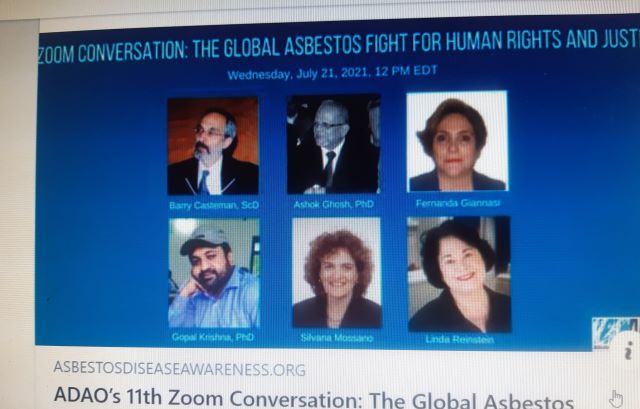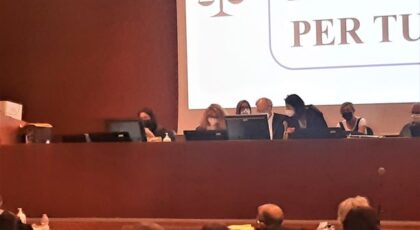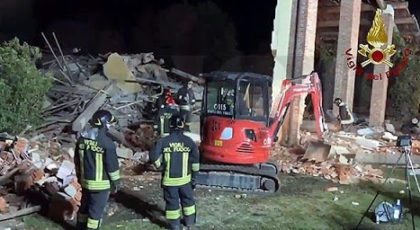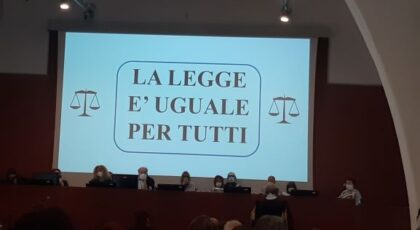SILVANA MOSSANO
Il 21 luglio si è svolto un webinar meeting internazionale, promosso dall’Adao (l’associazione statunitense omologa dell’Afeva casalese, che si batte contro l’amianto), per iniziativa della tenace ed energica presidente Linda Reinstein, da Los Angeles, e in collegamento con il Canada, il Brasile, l’India e l’Italia. In diretta streaming è stato trasmesso anche su Facebook, seguito da attivisti di diverse parti d’Europa e del mondo. Titolo della conversazione: «The global asbestos fight for Humar right and justice» (La lotta globale all’amianto per i diritti umani e la giustizia).
Sono intervenuti: Linda Reinstein, Barry Castleman, Gopal Krishna, Alec Farquhar. Per motivi tecnici, la pasionaria brasiliana della lotta all’amianto, Fernanda Giannasi, ha affidato il proprio intervento a Linda. Hanno collaborato Sarah Whitman e Ellen Costa.
Mi è stato affidato il compito di descrivere la situazione italiana. Di seguito la versione italiana del mio intervento e, via via, la preziosissima traduzione dell’interprete Vicky Franzinetti.
An international webinar meeting was held on July 21, 2021, sponsored by Adao US, thanks to the relentless work of the association’s energetic president Linda Reinstein, from Los Angeles and in connection with Canada, Brazil, India and Italy. Live streaming was also transmitted on Facebook, followed by activists from different parts of Europe and the world. Title of the conversation: “The global asbestos fight for human right and justice”.
Speakers: Linda Reinstein, Barry Castleman, Gopal Krishna, Alec Farquhar. For technical reasons, the Brazilian asbestos campaigner, Fernanda Giannasi, gave her talk to Linda. Sarah Whitman and Ellen Costa contributed.
I was entrusted with the task of describing the Italian situation. Below is the Italian version of my speech followed by the invaluable translation by the interpreter Vicky Franzinetti.
1 Introduzione
Sono giornalista da oltre quarant’anni e mi sono occupata molto delle questioni legate all’amianto.
A Casale Monferrato, la città dove vivo (al Nord, in Piemonte) e che conta, oggi, circa 32 mila abitanti, è stato operativo, per 80 anni, dal 1906 al 1986, il più grande stabilimento Eternit in Italia, dove si producevano manufatti contenenti amianto (qui, in particolare, si producevano tetti e grosse tubazioni, impiegate, ad esempio, per la rete dell’acquedotto. Per le tubazioni veniva usato il cosiddetto «amianto blu», cioè la crocidolite, il più terribile e cancerogeno).
Durante la mia professione, mi sono occupata delle vicende sindacali (tra cui la lunga e difficile battaglia per ottenere, nel 1992, la legge di abolizione dell’amianto in Italia), di quelle politiche (tra cui l’ordinanza del sindaco Riccardo Coppo, nel 1987, che vietò a Casale Monferrato, per primo in Italia, l’uso di amianto, cinque anni in anticipo rispetto alla legge nazionale), di quelle ambientali (le bonifiche e la realizzazione di un parco, chiamato Eternot, cioè «No Eternit», al posto dello stabilimento, prima sanificato e subito abbattuto perché non disperda più fibre d’amianto), quelle medico-scientifiche (per affrontare le malattie causate dall’amianto, in particolare il cancro mesotelioma, che qui continua a colpire non meno di una cinquantina di persone all’anno) e di quelle giudiziarie (a partire dai primi processi negli anni Ottanta e Novanta, per passare al maxiprocesso Eternit Uno, tra il 2009 e il 2014, e ora al processo Eternit Due).
Ho anche scritto un libro, intitolato «Malapolvere» (che significa polvere cattiva, malata, quella appunto di Casale che ha fatto morire centinaia di persone e continua a far morire), uscito a dicembre 2010, da cui è stato tratto lo spettacolo con lo stesso titolo ideato e interpretato dall’attrice Laura Curino. Inoltre, ho scritto, con il collega Michele Brambilla, il libro «Morire d’amianto», edito da La Stampa e uscito in ebook nel 2012.
Attualmente, anche se ho smesso di lavorare per i giornali, continuo, come impegno personale e per rispetto sia alle vittime dell’amianto sia ai miei concittadini, a seguire in presenza il processo Eternit Bis, documentandolo udienza dopo udienza sul mio sito www.silmos.it.
1 INTRODUCTION
I have been a journalist for over forty years. As a reporter, I dealt extensively with asbestos-related issues.
I live in Casale (in the Northern Italy, in Piedmont, population of about 32,000 inhabitants).
The largest Eternit plant in Italy was in operation in Casale Monferrato for 80 years, from 1906 to 1986. The plant manufactured product containing asbestos, specifically roofs and large pipes for aqueducts. They used “blue asbestos” was used, i.e.: crocidolite, the most terrible and carcinogenic for the pipes.
In my years as a journalist, I have been involved in reporting on industrial and workers & union events including the long and difficult battle to have asbestos banned in Italy in 1992, politics, including the ordinance by Casale’s mayor Riccardo Coppo, who in 1987, banned the use of asbestos, five years before the national law and first in Italy, environmental affairs (the reclamation and the creation of a park, called EterNot, that is “No Eternit”, in the place of the plant, first decontaminated and immediately demolished so that it no longer released asbestos fibers), the medical and scientific issues (to address the diseases caused by asbestos, in particular mesothelioma cancer, which continues to affect no less than fifty people a year in our city, and the judicial ones starting from the first trials in the Nineteen-Eighties and Nineties, to the Eternit One maxi-trial, between 2009 and 2014, and now the Eternit Two trial.
I also wrote a book, entitled “Malapolvere” (which means bad, sick dust, the kind from Casale that has caused hundreds of people to die and continues to do so), published in December 2010. A show by the same title was interpreted by actress Laura Curino. In addition, with my colleague Michele Brambilla, I wrote the book “Morire d’amianto” (Dying of Asbestos), published by La Stampa and released as an e-book in 2012.
Currently, although I am no longer working for the newspapers I continue, as a personal commitment and out of respect for the victims of asbestos and for my fellow citizens, to follow the Eternit Bis trial, documenting hearing after hearing on my website www.silmos.it.
* * *
2 Che cosa ha fatto l’Eternit e che effetto ha avuto sulla popolazione e sull’ambiente?
L’Eternit è stato ed è (in alcune zone del mondo) uno dei colossi industriali che impiegano l’amianto, in modo massiccio, nella loro produzione. Ha avuto stabilimenti in diversi Paesi, tra cui in Europa. Per decenni è stato di proprietà della famiglia svizzera Schmidheiny. L’ultimo proprietario in vita è Stephan Schmidheiny, che ha poco più di 70 anni, e che ha gestito direttamente l’Eternit, comprese le fabbriche italiane, a partire dal 1976. Quello di Casale, il più grande e il più vecchio tra gli stabilimenti italiani, è stato chiuso nel 1986. Qual è la responsabilità che gli viene contestata? Non di aver prodotto i tetti e le tubazioni usando amianto, perché fino al 1992 in Italia era concesso dalla legge, quindi faceva una produzione legale, come anche altre aziende meno grandi (ad esempio la Fibronit). Però Schmidheiny, come è stato provato nel maxiprocesso Eternit Uno, era perfettamente a conoscenza che l’amianto è cancerogeno, c’erano studi internazionali. Lo sapeva e, tuttavia, ha continuato a usarlo, ma soprattutto a non impedire che la fibra si diffondesse malamente dentro la fabbrica e senza limiti fuori dalla fabbrica. Anzi, poiché lo stabilimento di Casale era vecchio e doveva essere dismesso, negli ultimi anni c’è stato un incremento di produzione per poter sfruttare gli impianti il più possibile, prima di chiuderlo nel 1986. Poi ha abbandonato tutto, senza bonificare e consentendo così che l’amianto ancora presente in modo massiccio continuasse a diffondersi. Questa diffusione criminale e consapevole ha causato centinaia di morti (a Casale, da che si è cominciato a contare, almeno duemila) e continua a fare vittime, oggi quasi esclusivamente persone che non hanno mai lavorato all’Eternit, ma, vivendo a Casale, hanno respirato la polvere che si è diffusa. La fibra respirata rimane piantata nei polmoni anche decenni e, dopo lunga latenza, può accadere, come accade purtroppo, che si manifesti il cancro maligno chiamato «mesotelioma». I difensori di Schmidheiny insistono dicendo che lui non sapeva e che ha fatto investimenti per limitare la diffusione della fibra. Nel maxiprocesso si è accertato invece che sapeva e che i soldi spesi più che alla prevenzione erano finalizzati a incrementare la produzione con impianti più efficienti. L’imprenditore svizzero nel maxiprocesso era stato condannato in primo grado a 16 anni, in secondo grado a 18 anni, ma la prescrizione decisa dalla Corte di Cassazione ha cancellato tutto; cioè, ha cancellato il fatto che Schmidheiny debba scontare la condanna, ma non ha negato che lui sia responsabile del disastro doloso di cui era accusato.
2 What did Eternit do and what effect did it have on the population and the environment?
Eternit was and is (in some areas of the world) one of the industrial giants that use asbestos, in a massive way, in their production. It had -and has in some cases- plants in several countries, including Europe. For decades it was owned by the Swiss Schmidheiny family. Stephan Schmidheiny, who is just over 70, and who managed Eternit, including the Italian factories since 1976, is/was the last living owner. The one in Casale, the largest and oldest of the Italian plants, was closed in 1986. What is he accused of? Not of having produced roofs and pipes using asbestos, because until 1992 in Italy it was allowed by law, therefore manufacturing was legal, like other less big companies (for example Fibronit). However, Schmidheiny, as proven in the Eternit One maxi-trial, was perfectly aware that asbestos was carcinogenic, that there were international studies. He knew it and yet he continued to use it, but above all he did not prevent the fiber from spreading inside the factory and freely outside the plant. On the contrary, since the factory in Casale was old and had to be closed, in the last years there was an increase in production to exploit the facilities as much as possible, before closing it in 1986. Then he abandoned everything, without decontaminating and thus allowing the massive amounts of asbestos still present to spread all over the city. This criminal and conscious act has caused hundreds of deaths (in the town of Casale, since we started counting, at least two thousand, more in the surrounding area) and continues to kill, now almost exclusively affecting people who never worked at the Eternit plant, but, living in Casale, who breathed the dust that had spread. The fiber remains planted in the lungs even for decades and, after long latency, it can – and unfortunately does – cause the growth of a malignant cancer called “mesothelioma”. Schmidheiny’s defence insist that he did not know and that he made investments to limit the spread of the fiber. In the first trial, however, it was proven that he knew, and that the money spent was aimed at prevention, but to increase production more efficiently. At the end of the trial, the Swiss entrepreneur was sentenced to 16 years and to 18 years in the Court of Appeal, but the statute of limitations ruled by the by the Court of last resort (the Court of Cassation) required a retrial; that is, it cancelled the fact that Schmidheiny had to serve his sentence, but it did not deny that he was responsible for the wilful disaster he was accused of. This time he is being tried in a Court of Assizes.
* * *
3 Che conseguenze ha avuto l’Eternit sull’ambiente?
Sulla vita delle persone ho già detto: ci si continua ad ammalare e a morire, non si sa fino a quando. Certo, si sono fatte molte bonifiche in questi anni e Casale è forse la città più bonificata al mondo; ma le bonifiche sono costate milioni e milioni e costano moltissimo alla collettività. Ma non sono finite. Sono stati impiegati soldi dello Stato e delle altre istituzioni, oltre a quelli dei privati cittadini.
3 What consequences has Eternit had on the environment?
I have already said that people continue to fall ill and die, and we do not know how long for. Of course, decontamination has been carried out in recent years and Casale making it unquestionably the most decontaminated city in the world; but it has cost the community millions and millions, and it is not finished. Money from the State and other institutions has been used, as well as private citizens’.
* * *
4 Cosa state facendo per ottenere giustizia? E a che punto è il nuovo processo
Da più di trent’anni i casalesi chiedono giustizia. Quale giustizia si chiede? Prima di tutto il riconoscimento penale, sancito da una sentenza definitiva e inoppugnabile, che un torto è stato commesso e che, in conseguenza di questo torto compiuto attraverso un reato, si sono ammalate e sono morte centinaia di persone. E, purtroppo, non si sa fino a quando lo stillicidio continuerà.
Con caratteristiche diverse si erano già fatti processi negli anni Ottanta e Novanta. Poi si è arrivati al cosiddetto «maxiprocesso Eternit 1» in cui Stephan Schmidheiny è stato riconosciuto colpevole in primo e in secondo grado di disastro doloso ambientale, e condannato prima a 16, poi a 18 anni. Ma la Cassazione ha spazzato via tutto, affermando che era passato troppo tempo dalla chiusura della fabbrica nel 1986 per tener in piedi quel tipo di accusa, cioè il disastro. Non ha negato la responsabilità dell’imputato, ma ha ritenuto che non potesse essere applicata la pena inflitta.
La procura della Repubblica di Torino ha dunque proposto un nuovo processo, l’Eternit Bis, con una imputazione diversa: l’omicidio doloso, cioè volontario, di un certo numero di casalesi morti d’amianto. Le vittime, in realtà, sono molte di più rispetto alle 392 indicate nel capo d’accusa, ma è soltanto un campione di quelli effettivamente morti. Sono elencati sia ex lavoratori (63) sia cittadini (oltre 300) che non hanno mai lavorato all’Eternit e tuttavia sono stati uccisi dal mesotelioma. Schmidheiny deve rispondere di quel grave reato davanti alla Corte d’Assise, composta di giudici di carriera e di giudici popolari. I difensori, nelle settimane scorse, hanno sollevato obiezioni insistendo sulla nullità degli atti e sulla incostituzionalità del processo. Ma lunedì 19 luglio la Corte d’Assise ha respinto quelle argomentazioni e ha aperto ufficialmente il dibattimento. Dal 13 settembre si entrerà nella parte più lunga e dolorosa del processo, durerà mesi e mesi, perché ognuno dei 392 casi di morte verrà esaminato nel dettaglio, finanche a mettere in dubbio – come ha preannunciato la difesa dell’imputato – le diagnosi di mesotelioma, soprattutto per i casi in cui queste diagnosi non sarebbero sostenute da inoppugnabili evidenze scientifiche.
4 What are you doing to get justice? And how far along is the retrial?
For more than thirty years, the people of Casale have been asking for justice. What justice are they asking for? First of all, recognition of it being a crime, which sanctioned by a definitive and incontrovertible sentence, that a wrong was committed and that, as a result of SS’s wrong-doing, hundreds of people fell ill and died. Unfortunately, we do not know how long it will last.
Trials took place in the 1980s and 1990s: then came the so-called ” Eternit 1 maxi-trial” which rules Stephan Schmidheiny was guilty of intentional environmental disaster, and sentenced first to 16, then 18 years in lower court and them the court of appeal. However, the Court of last resort, the Court of Cassation swept it all away, stating too much time had passed since the closure of the factory in 1986 for that charge to hold, of accusation, i.e., disaster. The court did not question the defendant’s responsibility but considered that the sentence fell under the statute of limitations.
The Turin Public Prosecutor’s Office proposed a new trial with a different indictment: intentional, i.e.: voluntary murder of a number of people from Casale who died of asbestos. There are many more victims, are many more than the 392 indicated in the indictment, but they are only a sample of those who actually died. It lists both former workers (63) and members of the community (over 300) who never worked at Eternit and yet were killed by mesothelioma. Schmidheiny will be heard by the Court of Assizes, with Judges and a Jury (aka popular judges). In recent weeks, the defence lawyers raised objections insisting on the unconstitutional nature of the trial and of the exhibits submitted. However, on Monday 19 July, the Court of Assizes rejected the objections and officially opened the trial. From September 13, the longest and most painful part of the trial will begin, and it will last for months and months, because each of the 392 cases of death will be examined in detail, even to the point of questioning – as the defendant’s defense has announced – the diagnoses of mesothelioma, especially for those cases in which the diagnoses would not be supported by unquestionable scientific proof.
* * *
5 Come possiamo aiutarvi?
Come potete aiutarci? Forse è meglio dire: come possiamo aiutarci? Vedete, l’amianto non è un problema solo di Casale Monferrato, è un problema di tutto il mondo. Non ci si ammala e non si muore solo a Casale, ma ovunque, in Italia e in tutto il pianeta. I cittadini di Casale, a partire da un piccolo drappello di persone tenaci che hanno fondato l’Afeva (Associazione famigliari e vittime amianto) oltre trent’anni fa, hanno reagito al dolore – che è tanto, è proprio tanto, e alla paura di ammalarsi, che è tanta, è proprio tanta e sempre presente, anzi la paura stessa è già una malattia –; i casalesi, dicevo, hanno reagito al dolore e hanno combattuto, prima di tutto perché si sapesse quel che è accaduto, qui e altrove.
Come possiamo aiutarci tutti insieme? Raccontando quel che è avvenuto e quel che ancora accade. Con realismo e pacatezza, per essere credibili e autorevoli. La preoccupazione degli industriali dell’amianto (e credo valga anche per altri settori «pericolosi») è che gli interrogativi delle persone, le proteste, le pretese di miglioramento delle condizioni di lavoro e di rispetto dell’ambiente possano diffondersi troppo nell’opinione pubblica. E’ emerso anche dalle carte del maxiprocesso Eternit Uno: si diceva che era fondamentale che il «rumor» rimanesse circoscritto in ambito locale. Per molto tempo ci sono riusciti anche con una diffusa propaganda. E i giornali locali, che pure da un certo momento in poi sollevarono il problema, non andavano oltre i confini del posto. Adesso, invece, con internet si può far sentire la voce e diffonderla ovunque. Come ha detto bene Bruno Pesce, uno dei maggiori attivisti contro l’amianto, noi, tutti insieme, siamo la «multinazionale delle vittime dell’amianto». E, come ha urlato Romana Blasotti Pavesi, la prima presidente dell’Afeva, rivolgendosi a chi ostacola questa battaglia, «noi siamo più tanti di voi».
Il problema è che, dopo anni di lotta, le forze vengono meno. E, talora, anche la fiducia e la speranza. Resistiamo, anzi «resiliamo», ma contiamo sui ragazzi. Noi speriamo che, da settembre, possano partecipare al processo Eternit Bis, almeno una classe di studenti a ogni udienza. E’ importante che siano presenti, come severi osservatori che pretendono si faccia giustizia. Ce ne sono di molto sensibili, gli insegnanti stanno lavorando molto per questo e i risultati sono evidenti e preziosi. I ragazzi, proprio pochi giorni prima che iniziasse il processo Eternit Bis, hanno lanciato un messaggio: «Noi ci siamo». Ecco, abbiamo bisogno di questo: esserci. Fino a che non sarà finita e, cioè, quando dell’amianto e del mesotelioma si leggerà soltanto nei libri di storia.
5 How can we help you?
How can you help us? Perhaps it would be better to say: how can we help? You see, asbestos is not just a problem in Casale Monferrato, it is a problem all over the world. People do not get sick and die only in Casale, but everywhere, in Italy and all over the planet. Starting from a small group of tenacious people who founded the Afeva (Association of families and asbestos victims) over thirty years ago, the people of Casale, have reacted to the pain – which is a lot, it is really a lot, and to the fear of getting the disease, which is a lot, really fierce and always present, indeed fear itself is already a disease; the people of Casale, I was saying, have reacted to the pain and have fought, first of all so that people would know what happened, here and elsewhere.
How can we all help each other? By telling what happened and what is still happening. With realism and calm, being credible and authoritative. The concern of the asbestos industry (and I believe it also applies to other “dangerous” sectors) is that people’s questions, protests and demands for improved working conditions and respect for the environment may spread too far in public opinion. This also emerged from the papers of the Eternit Uno maxi-trial: the company said that it was fundamental that the rumors remain circumscribed in the local area. For a long time, they succeeded, spreading propaganda. The local newspapers from a certain moment onwards raised the problem, but again it did not go beyond the local boundaries. Now, however, with the Internet, we can raise our voices and spread the information. As Bruno Pesce, one of the foremost activists against asbestos, said so well, we are the “multinational corporation of asbestos victims“. And, as Romana Blasotti Pavesi, the first President of Afeva, shouted, addressing those who try and stop this battle, “there are more of us than you “.
The problem is that, after years of struggle, people are tired. And sometimes we lose confidence and hope. We are resisting, or rather we are resilient, but we are counting on the next generation, on our children. We hope that, from September, at least one class of students will be able to participate in the Eternit Bis trial at each hearing. It is important that they be present, stern observers who demand that justice be done. Some are deeply aware; the teachers are working hard for this and this is getting results. Just a few days before this Eternit Bis trial began, the young people sent out a message: “We are here“. This is what we need: for them to be there. Until it is over, and that is when asbestos and mesothelioma will only be chapters in history books.




